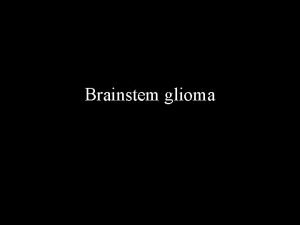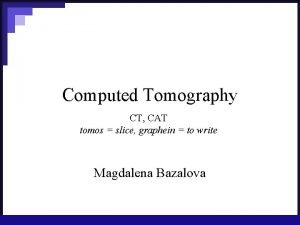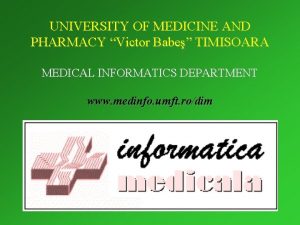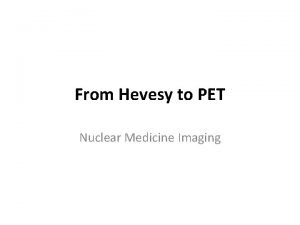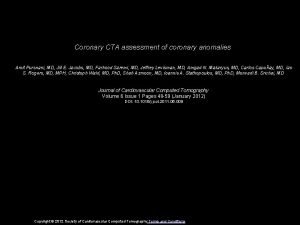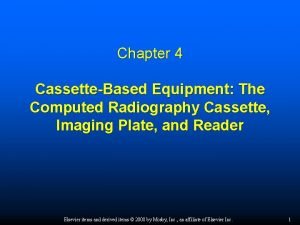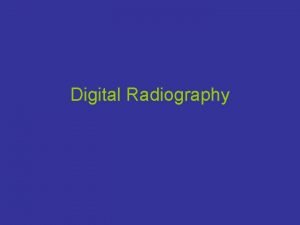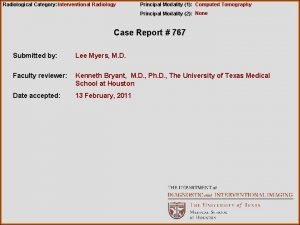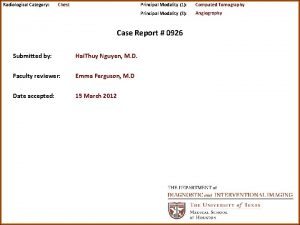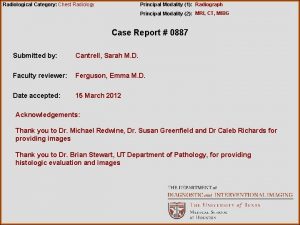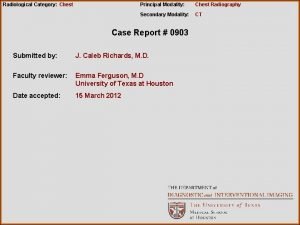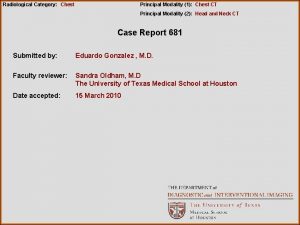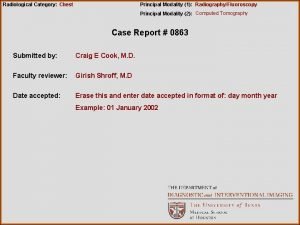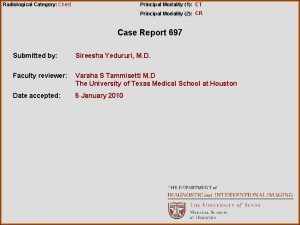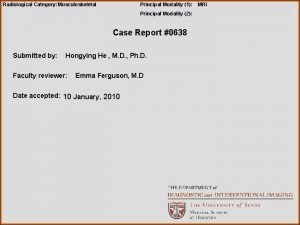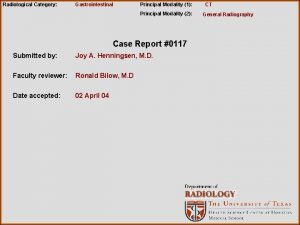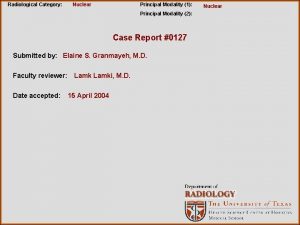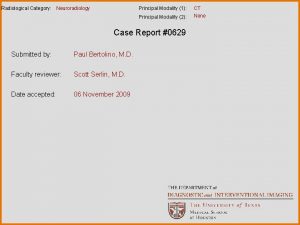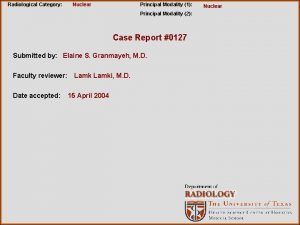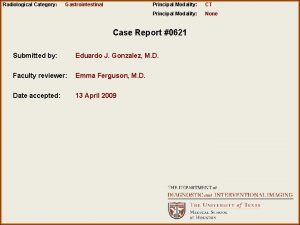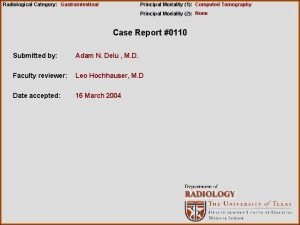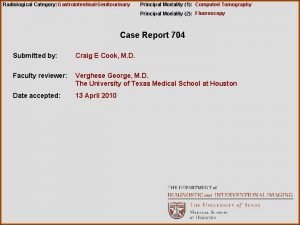Radiological Category Chest Radiology Principal Modality 1 Computed



















- Slides: 19

Radiological Category: Chest Radiology Principal Modality (1): Computed Tomography Principal Modality (2): General Radiography Case Report 692 Submitted by: Lee Myers, M. D. Faculty reviewer: Emma Ferguson, M. D. The University of Texas Medical School at Houston Date accepted: 03 March 2010

Case History 50 year-old female with chest pain.

Radiological Presentations Presenting Chest Radiograph 1/2009

Radiological Presentations 1/2010

Radiological Presentations 1/2010

Radiological Presentations 1/2010

Radiological Presentations 1/2010

Radiological Presentations 1/2010

Comparison CT’s at the same level 11/2008 8/2009 1/2010

Test Your Diagnosis Which one of the following is your choice for the appropriate diagnosis? After your selection, go to next page. • Recurrent infection causing bronchiectasis with calcified and noncalcified granulomatous disease. Incidental note of situs inversus. • Kartagener Syndrome with granulomatous disease with incidental note of biliary manipulation. • Kartagener Syndrome with metastatic pancreatic cancer status post Whipple procedure. • [Add as needed]

Findings The initial chest radiograph demonstrates situs inversus totalis with dextrocradia and the stomach bubble on the right (red arrow). There are multiple nodular opacities bilaterally with the largest in the left mid lung (black arrow). Incidental note of a calcified granuloma in the right upper lobe.

Findings The chest CT demonstrates situs inversus and bronchiectasis (yellow arrow) within the lingula. There also multiple spiculated nodules (red arrows) in the lungs bilaterally. Also noted is pneumobilia (green arrow).

Differentials: • Recurrent infection causing bronchiectasis with calcified and noncalcified granulomatous disease. Incidental note of situs inversus. • Kartagener Syndrome with granulomatous disease with incidental note of biliary manipulation. • Kartagener Syndrome with metastatic pancreatic cancer status post Whipple procedure. • [Add as needed]

Discussion Kartagener syndrome was first described in 1904 as a combination of situs inversus, chronic sinusitis, and bronchiectasis. This is inherited as an autosomal recessive pattern.

Discussion Kartagener syndrome is in a larger group of disorders referred to as primary ciliary dyskinesias. The typical ciliary axoneme has 2 central microtubules and 9 peripheral microtubular doublets as seen in figure A (arrows are pointing to the inner and outer dynein arms). Figure B demonstrates a disorganized configuration of the microtubules and decreased number of dynein arms seen in Kartagener syndrome. Figure A Figure B

Discussion The disorganization of the microtubules within the cilia effectively limits the coordination of beating cilia, which ultimately leads to the lack of mucociliary clearing. Ciliated epithelium is found in the upper respiratory tract, nasal mucosa, paranasal sinuses, middle ear, and eustachian tubes. Uncoordinated cilia can lead to the following: Chronic sinusitis Recurrent otitis media Chronic bronchitis, recurrent pneumonia, and bronchiectasis Obstructive lung disease due to chronically irritated airway Diminished female fertility Sterility in males due to immotile spermatozoa

Discussion Additional findings of the CT included new spiculated nodules likely representing metastatic pancreatic cancer. The patient had a Whipple procedure previously for pancreatic cancer and had subsequently developed pneumobilia, which can be seen status post choledochojejunostomy.

Diagnosis Kartagener syndrome with metastatic pancreatic carcinoma to the lungs status post Whipple procedure with subsequent pneumobilia.

References Webb, WR, Higgins, CB, Thoracic Imaging. Lippincott Williams & Wilkins 2005. P. 540. Lepanto, L, Gianfelice, D. Postoperative Changes, Complications, and Recurrent Disease After Whipple’s Operation: CT Features. AJR 1994; 163: 841 -846 Kartagener Syndrome, Http: //emedicine. medscape. com/article/299299 -overview Swiss group for Interstitial and Orphan Lung Diseases, Https: //www. siold. ch/registry/opencms/siold/information. For. Physicians/ifp_4_2. html
 Erate category 2
Erate category 2 Center for devices and radiological health
Center for devices and radiological health National radiological emergency preparedness conference
National radiological emergency preparedness conference Radiological dispersal device
Radiological dispersal device Tennessee division of radiological health
Tennessee division of radiological health Computed tomography
Computed tomography Ring artefact
Ring artefact The zj row in a simplex table for maximization represents
The zj row in a simplex table for maximization represents Data acquisition system in ct scan
Data acquisition system in ct scan Computed tomography timisoara
Computed tomography timisoara Positron emission tomography
Positron emission tomography Variable cost per unit example
Variable cost per unit example Hematome
Hematome A computed is a calculation that a dbms performs
A computed is a calculation that a dbms performs Journal of cardiovascular computed tomography
Journal of cardiovascular computed tomography Cr imaging plate layers
Cr imaging plate layers Tracking signal definition
Tracking signal definition Sulphonal casset
Sulphonal casset Sodality vs modality
Sodality vs modality Modality in software engineering
Modality in software engineering





